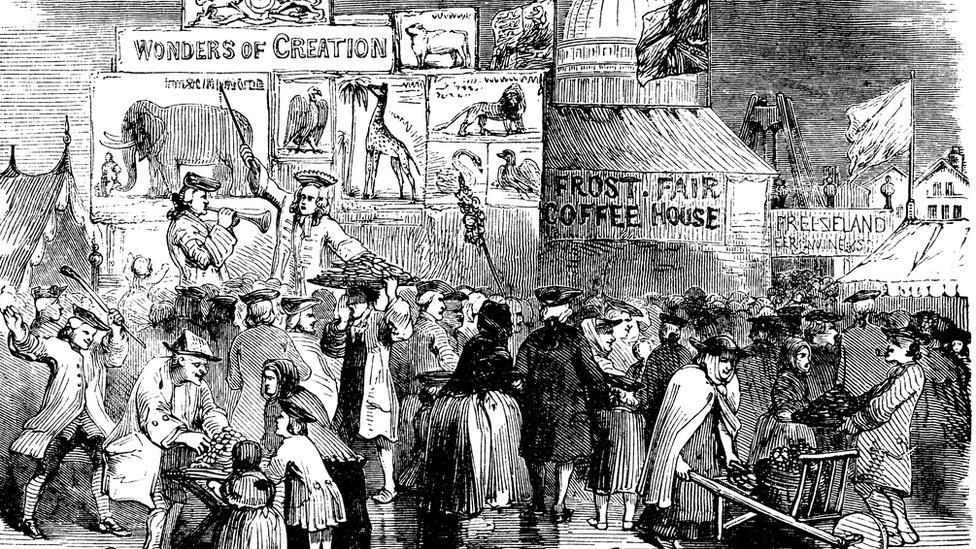Weather history: Frost fairs in the Little Ice Age
- Published

Imagine a winter so severe and prolonged that the River Thames in central London completely froze over with ice so thick there was a "carnival on the water".
It surely must have been the highlight of the season back in the day.
Little Ice Age
From roughly the 14th to the 19th centuries, Britain and the rest of the northern hemisphere were locked in a "Little Ice Age".
It is thought that the global temperature dropped by 0.5C during this time and looking at the evidence, it appears there might have been several factors at play.
Firstly, it was a period with increased volcanic eruptions, leaving the atmosphere heavy with aerosols and so less solar radiation could reach the Earth.
Scientists also wonder whether there was significantly reduced solar activity, as historically very low magnetic Sun activity has coincided with documented cold spells.
Changes in ocean currents and atmospheric conditions might also have been a factor. Scientists think there was a prolonged period when the Northern Hemisphere atmospheric circulation was reversed bringing harsher winters during this time. A modern day comparison would be a Beast from the East.
The Frost Fair of the winter of 1683-84 on the Thames, with Old London Bridge in the distance
Another factor to consider would be diseases such as the Black Death, which led to a significant decline in both human and animal populations, reducing greenhouse gas emissions, which are known to warm the atmosphere.
Frost Fairs
Winters in the mini ice age were more severe than nowadays. The Thames froze at least 20 times, sometimes for two months or more, and between 1607 and 1814 there were five or six occasions when the ice was thick enough to hold a fair on the river.
Frost fairs were a huge festival on the ice with bowling matches, football pitches, food and drink stalls and even a pub.
The ice was so firm in some places that elephants skated on the ice as part of a circus act and shopkeepers kept warm by lighting fires inside their tents.
Freezing conditions around Beverley Brook, a tributary of the Thames at Richmond, Greater London, in November 2021
The last frost fair in London was in 1814, and despite some extremely cold winters since, such as 1881, 1895 and 1962-63 - the latter the coldest winter for 200 years, when the higher Thames last froze over - there haven't been any more fairs.
The Thames of the past is very different from that of today. In those days, the wider and shallower footprint, without the modern stone embankments constructed in the Victorian era, meant it was easier for the water to freeze.
Also, since the last frost fair of 1814, Old London Bridge, a medieval wooden bridge supported by 19 wooden piers, has been replaced by a more modern structure with wider arches to allow a freer river flow. This also allows salty sea water to penetrate further upstream, and salt water has a lower freezing temperature.
Could there be another ice age?
It seems most unlikely that this could happen again - 2023 was the warmest year on record and this year could be even hotter globally.
A number of data sets indicate that 2023 was the warmest year on record.
Our planet continues to warm at an alarming rate, with temperatures around 1.5C higher since the industrial revolution.